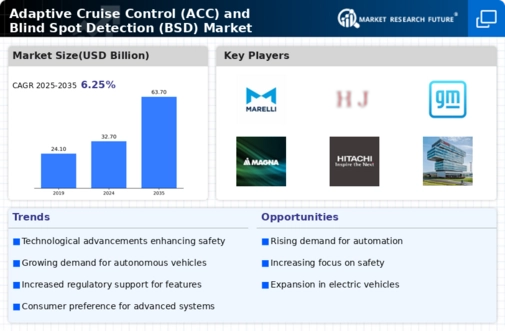The Adaptive Cruise Control (ACC) and Blind Spot Detection (BSD) Market has been witnessing significant growth driven by increasing consumer demand for advanced driver assistance systems and growing awareness of vehicle safety features.
As automotive technology progresses, manufacturers are investing heavily in the development of innovative solutions that not only enhance driving experiences but also significantly contribute to road safety.
The intensifying competition among key players shapes the market landscape, requiring companies to continuously innovate and differentiate their offerings to capture market share.
The rising trend of vehicle connectivity and automation is further propelling the demand for ACC and BSD systems, leading to strategic collaborations, partnerships, and mergers within the industry as companies aim to leverage complementary strengths and technologies.
Marelli has established a strong presence in the Adaptive Cruise Control (ACC) and Blind Spot Detection (BSD) Market by leveraging its extensive expertise in automotive solutions. With a commitment to innovation, Marelli focuses on delivering high-quality systems that integrate seamlessly with modern vehicles.
The company's strengths lie in its advanced radar and camera-based technologies, which have shown remarkable performance in various driving conditions, providing enhanced safety and convenience to drivers.
Marelli's deep understanding of market trends and consumer requirements allows it to remain agile and responsive, positioning itself as a key player in this competitive landscape. Through sustained investments in research and development, Marelli is continuously advancing its product offerings, contributing to the proliferation of ACC and BSD technologies.
Hella is another prominent player in the Global Adaptive Cruise Control (ACC) and Blind Spot Detection (BSD) Market, recognized for its robust portfolio of innovative automotive electronics and lighting solutions.
Hella's strengths are rooted in its strong focus on research and development, which enables the company to stay ahead of technological advancements and market trends. With a growing emphasis on vehicle safety and automation, Hella has been effectively integrating its cutting-edge sensor technologies into ACC and BSD systems, providing clear advantages in terms of functionality and reliability.
The company's commitment to sustainability and enhanced driving experiences further solidifies its reputation in the market. As a result, Hella continues to play a crucial role in shaping the future of automotive safety solutions, navigating the challenges and opportunities presented by the evolving landscape of the automotive industry.















